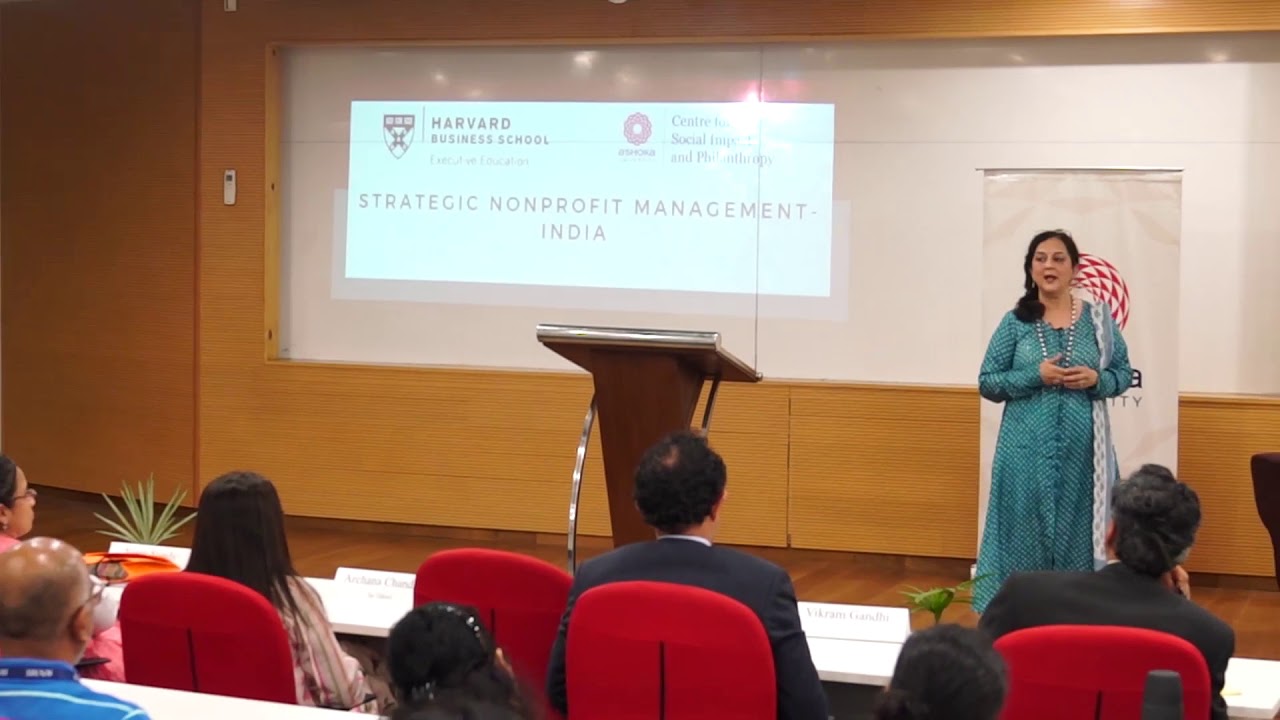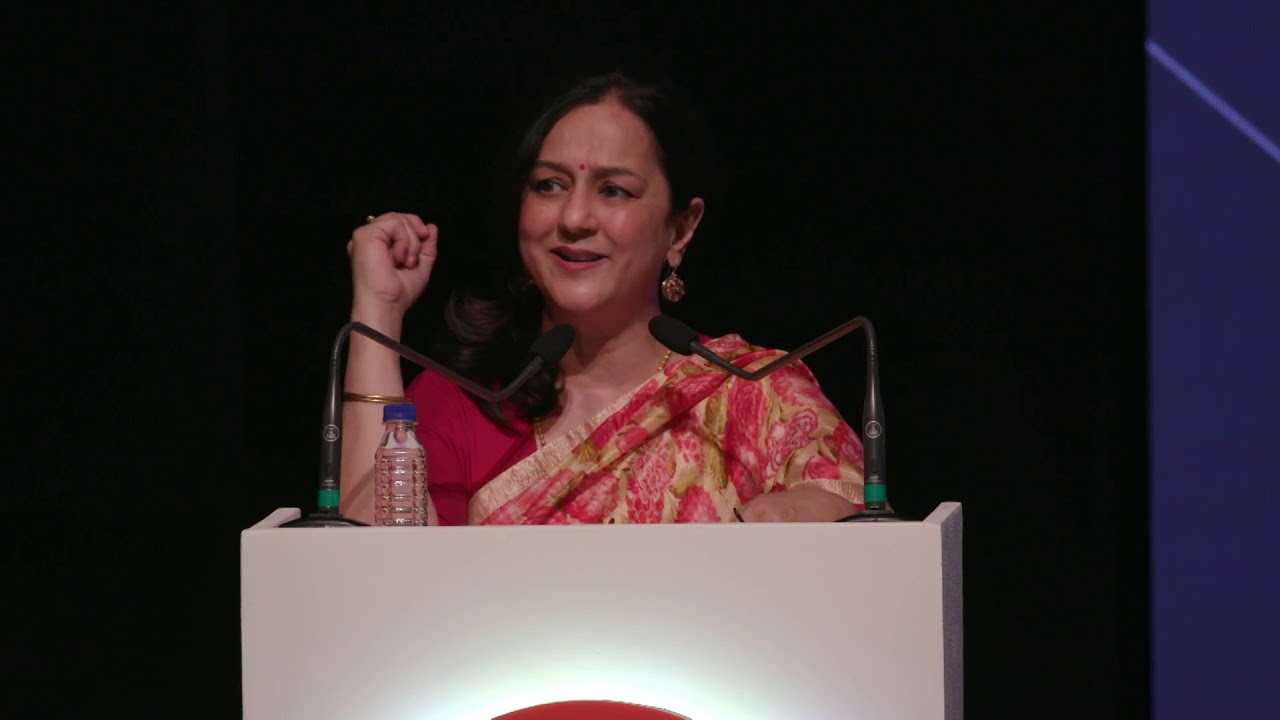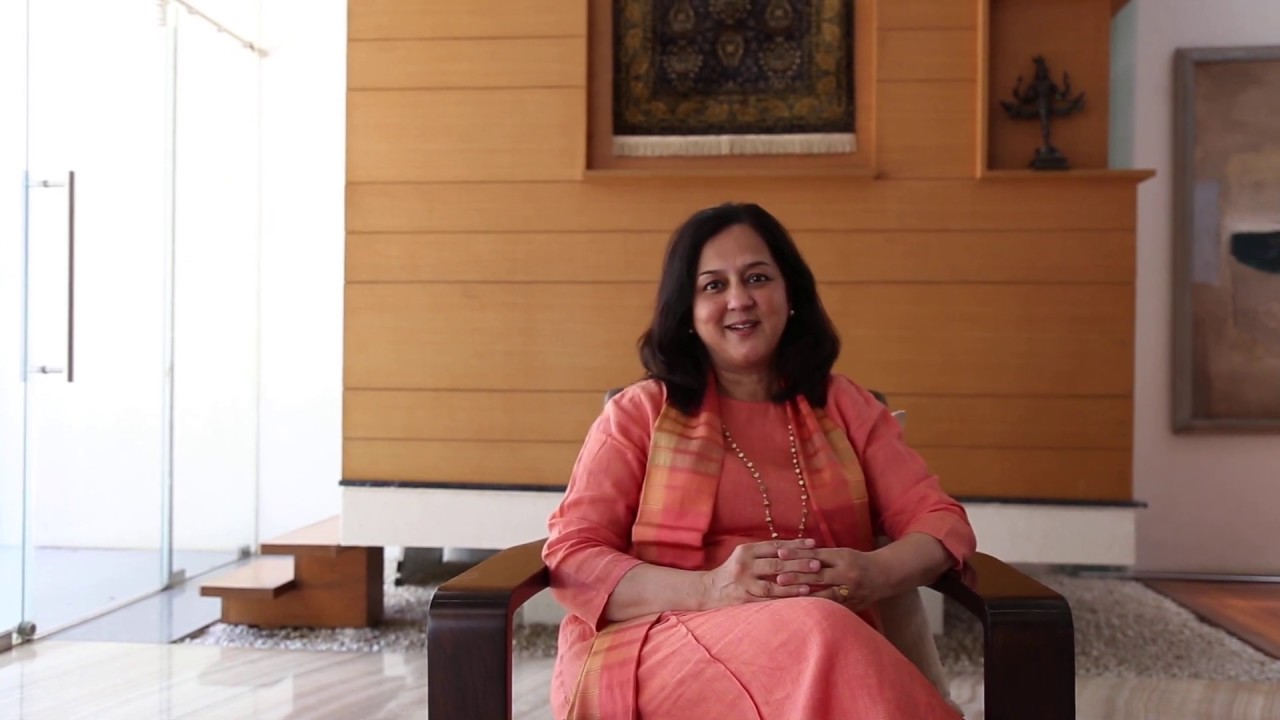This is an edited version of Rohini Nilekani’s closing keynote address delivered to the 2019 class of the Strategic Non-Profit Management – India offered developed in conjunction with the HBS Social Enterprise Initiative and offered in association with the Centre for Social Impact and Philanthropy at Ashoka University.
I think we are at a fairly critical time. People often refer to the social sector as the third sector, but I would argue that it actually has to be the first sector. In the continuum of Samaaj (society), Bazaar (the marketplace), and Sarkaar (the state), Samaaj must come first. Bazaar and Sarkaar were created to serve Samaaj. Samaaj includes all of us, and it created the Bazaar to serve its economic interests, and the Sarkaar to serve equality to all people, on a large scale.
But what has happened over the centuries, especially the last century, is that the state and the market have acquired tremendous power. Technological advancement has enabled the accumulation of that power in ways completely unimaginable even a few years ago. It is crucial that we understand the implications of the accumulation of power by the state and markets. In our hearts, we are citizens first. We are not consumers first, though sometimes a couple of companies would like us to forget that nowadays. And we are not subjects first, though a few governments might like us to forget that too. We are citizens first, we are human society members first, and we create institutions of social organization that are supposed to increase the well-being of Samaaj, but also hold the Bazaar and Sarkaar accountable.
Balancing the Scales
Both Bazaar and Sarkaar have grown extremely successful at driving scale, especially over the last few years. The market will always chase profits, acquire more customers, and accumulate power. Similarly, when the state achieves scale, it accumulates a lot of power for its continuing legitimacy. Both these forms of accumulation of power can create tremendous public good. Markets improve our lives in amazing ways every single day. The state enables the distribution of public services in a way that a sole individual could not possibly achieve.
So, what I’m talking about is more of a checks and balances mechanism that we need in the social sector, to hold these powers accountable to society. I think today, civil society has an especially critical role in holding the state to increase equity, along with efficiency, and holding the markets to reduce negative externalities to society. And it’s a very interesting time to do this because both the state and the market have also recognised that they cannot do anything on their own. Human problems are so interconnected today, especially driven by things like climate change, that the state and the market are quite open to the intervention of civil society in many areas.
While at the same time, there are other global threats as well. The three freedoms of democracy – the right to speak freely, the right to associate freely, and the right to practice one’s own beliefs, come with duties which we do not talk about enough. People must have the right to speak freely, but without deliberately hurting others; the right to form associations without turning into mobs; and the right to practice one’s beliefs, without preventing others from practicing theirs. So there are duties and rights, but these freedoms are increasingly coming under various kinds of shadows.
Never has it been more important for all of us in the social sector to play that balancing role. While the state and markets have been remarkably successful at achieving scale, it always remains a question whether the social sector can do that. I wonder if being unable to scale is a failure of imagination on our part. Mahatma Gandhi did not just try to improve the lives of people in Porbandar District. He did not just try to improve the lot of all of the citizens of India. He was trying to transform humanity at its core. His imagination was that big and nothing would come in the way. The trade-offs were not going to be that we would get independence by sacrificing our humanity. That was the scale of the imagination of his work.
There are so many other examples. Take someone like Vinoba Bhave. He was not trying to rescue land from just one district. He was talking about the redistribution of land, a very primary source of inequity in this country, across the nation. Jayaprakash Narayan’s Sampoorna Kranti was not only about one class or one identity group replacing the other. It was an imagination at a much loftier level. And that’s how they achieved scale, because the scale of their imaginations and their intent was powerful and very clear in their minds. Have we, perhaps, in the first sector lost a bit of that zeal for imagination? Sometimes I wonder about that. We belong to the tribe of Gandhiji, Vinoba Bhave, and Jayaprakash Narayan, and we need to look to the state and markets to understand how we can achieve scale in this sector as well.
The Need for Societal Platform Thinking
The motivation for scale is different in all three sectors. In the social sector, our goal is to improve human dignity, to create better access to goods and services, to restore agency, to increase creativity, and much more. Essentially, it is to give Izzat, Insaaf, and Imandari (respect, justice, and truth) to people. That is our real job, no matter which sector you work in. So when we want to scale, can we think of scale the same way that the Sarkaar or Bazaar does? I don’t think so.
Over the last 30 years, Nandan and I have been working in very different fields. Nandan has been a successful entrepreneur with Infosys, while doing philanthropic work. I have been working within the social sector for the last two and a half decades, helping individuals, institutions, and ideas spread and grow. Through our work, the goal was to create more public goods in the public sphere, but we have also failed a lot in our work in the social sector. I’ve learnt that it’s far easier to become a unicorn in the market or to become a successful state, than it is to create real, lasting social change. I meet many billionaire philanthropists around the world and they express this very humbly after first thinking “If I can create a great business, why can’t I create a great social sector organization?” But when they actually try it, they find just how hard it is to create scale in the social sector. And that’s because we have to understand why scale is very different in this sector.
Since 2015, Nandan and I have been working together on EkStep, with the goal that we will reach the 200 million children in this country with increased access to learning opportunities. What keeps us together is that we have different but hopefully complementary skills and we have brought those skills together with the pursuit of this goal. We have learned a lot from each other and so we have developed something called Societal Platform Thinking. We have to be careful when we are trying to solve complex, interdependent societal problems. Our methods have to be based on certain morally undeniable principles and philosophies. We have arrived at five of these basic principles, to help us and others get started.
The first thing we have learned is that a single solution will not work, no matter how great it is. If our aim is to solve the problem at the root cause, and scale, we have to design to distribute the ability to solve. We need to trust people and their ability to be part of the solution implicitly. Everyone can learn, everyone can solve, and everyone can be part of the solution. It is a question of design: where people need to see clearly, and where they need to be trusted to get involved in coming up with solutions. So, we have to also distribute the ability to see to solve, and we’ve come up with more detailed architecture about how to do that. That was the first big thing.
A second thing that we have learnt over time is that resources like talent, people, and money are hard to come by. When trying to scale, in terms of public good, a lot is hard to come by. So, we began to think through this, and we found that if you unpack complex social problems, you often find a core that is common. When you look at the common core, you realize that there are ways to make those scarce resources plentiful. Because sometimes there is abundance under your nose, it just exists in different forms. For example, if we think about education, it is very difficult to find professional, competent teachers. It’s very hard to train great teachers. But if we look at the system, there are parents, and teachers in abundance. So, that’s a simple example of how you can find abundance and make scarce resource un-scarce. We need to keep this in mind when we design for scale.
The third learning that is very dear to my heart, is that if we want to scale in a country like India, you need to address the diversity of context. Most of the problems that require scale are contextual. The solution that might work in one place may not work 100 kilometers down the road or it needs a little extra spices to be added into the mix to really work well – whether it’s food or social solutions. There is a lot of diversity, and pushing something will not work. So how do you design to scale up diversity? How will your solutions and your framing work to reflect diversity at scale? For that, in your design, you have to create a unified but not uniform intervention, design, infrastructure, and framework. Unified because we all have to achieve the same goal.
And for that, of course, you need good feedback. You need a digital tech backbone to distribute the ability to solve because you need multidirectional feedback loops. You need data coming in, not just being sucked up at one end, but moving around all the streams so that people can use the data well, in whatever form and when they need it. So you do need technology. But we have learnt that you have to be technology-enabled. If you are technology-led, you tend to make a lot of mistakes about outcome-thinking, because technology-led solutions can give you a false sense of success. You can just rack up the numbers, rack up some data points, but you may not actually get the social outcome that you want. This is important to keep in mind, because people today can get carried away thinking that technology is the solution.
These are some of the building blocks we are using at EkStep to design and reach those 200 million people. Because of this kind of thinking, we are working with the state, civil society, and the markets to move the needle to reach those kids. And so, in the social sector, when we think of scale, not everybody needs to do 200 million, right? Obviously we can’t, if all of us are trying to chase billion and two billion numbers, it will be crazy. We need many people to be doing small things well, as well. We need social innovation labs that can take some of these ideas, because failure is very important.
Taking Risks and Embracing Failure
We all fail, but what is important is that we do not grow afraid of failure. I think a lot about Gandhiji, and how one of the reasons he went to South Africa was because he had failed as a lawyer. Imagine, that failure launched a transformational epoch for humanity. So we will all fail, but it’s how we deal with failure that’s going to be important. And so many of these social innovation labs allow for the pull and push of failing, getting up, failing again, and succeeding. It’s not that every organization needs to scale, but some of our ideas need to scale.
In this sector, it is very hard for us to acknowledge failure. Philanthropists are extremely risk-averse. Usually philanthropists are very successful in business, and they have taken huge risks to get there. But when they move to the social sector, they forget how to take risks. Since they are now dealing with people’s lives and futures and common public goods, they want every venture to succeed. Businesses are allowed to fail. In fact, failure in Silicon Valley is celebrated. But in the social sector, if you fail, you might adversely affect a thousand people’s lives because of your mistake. As social sector organizations, it is very hard to tell your donors that you have failed, while needing more money from them. It’s very hard to do that. So then everybody stumbles by trying to prove just how successful they are.
It is time that we create spaces and platforms where donors, foundations, and members of civil society organizations come together and destigmatize this notion of failure. The question we should now ask is, how do we deal with failure so that we can keep innovating? When we think about scale, failure is inevitable and necessary because without it there is no innovation, and without innovation, there is no solution for scale. The fear of failure may also lead to fear of scaling, and I think we are stuck somewhere within that fear. And there is not enough celebration of the failure that leads to other successes, like Gandhi’s first failure as a lawyer. We need to strive for platforms where donors and civil society organizations can meet in a safe space to talk about these problems.
Another thing I want to touch upon is how to think about scale in this digital age. Although we live in a digital age, civil society in India has a lot of catching up to do. Some of my civil society friends are downright technophobic, and they assume all technology is bad. This is a huge challenge for us as a country of people who are not digital natives but need to advance a younger population who are. We cannot afford to stay the way we are, we cannot stay outside the gates, because the accumulation of power is also happening digitally. Unless we understand how to work efficiently in a digital age, and through digital means, we will not have the internal resources and external tool kits to hold sarkaar and bazaar accountable. So, kicking and screaming, the Indian civil sector needs to come into the digital age, which means the donor community needs to support this as well.
At the heart of it all, we still want to restore dignity and agency to people. Theodore Roosevelt once said, “Look to the stars, but keep your feet on the ground”, and I think that is what we should keep in mind when we think about scaling our work, especially in the philanthropy sector.




